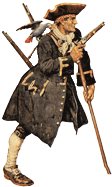R:
Some 17th century pirates were tattooed, although the tattooing techniques used at the time varied depending on where the tattoo was done and the pirate's culture of origin.
In general, tattooed pirates were mainly sailors and freebooters who had traveled to different parts of the world, which allowed them to acquire different tattoo traditions and cultural motifs.
So there were several techniques to tattoo themselves. One of the most common was to use bone or metal needles, often attached to a stick or rod, to pierce the skin and insert the ink. They could also use a needle used to stitch the sails of the ship. The ink used was usually made from natural substances such as charcoal or plant-based pigments.
The ink could also be finely ground gunpowder to create a permanent mark.
The finest tattoos, especially those of the greatest artists, are printed more deeply. They first make a rough drawing of the figure they want to draw with the brush and color; then they prick all around with a sharp thorn until blood gushes out; then they rub the place with their hands, dipped in the color they want to draw; and the image thus made is indelible.
As far as colors are concerned, pirates of the 17th century had access to pigments of different colors for their tattoos. However, it is important to note that black ink was the most common color for tattoos at the time.
There is no conclusive evidence of specialized tattoo artists among 17th century pirates. In general, pirates tattooed each other, often with the help of whoever had the most knowledge about tattooing. The designs used were often symbols of life at sea, such as anchors, dolphins, mermaids, ships, maps and compasses.
On the other hand, there is evidence of tattoos done by pirates. The buccaneer surgeon Lionel Wafer, writing in the 1680s, noted that "one of my companions once asked me to remove from his cheek one of these printed pictures, which was made by the negroes, his name was Bullman; which I could not do effectually, after much scarification and removal of a great deal of skin." (Lionel Wafer, in A New Voyage & Description of the Isthmus of America. Oxford: Hackluyt Society, 1934, page 83).
Indeed, Lionel Wafer was attempting to surgically remove a gunpowder spot, which was the common name for tattoos in English. The term came about as a result of the following process: drilling holes in the skin and rubbing finely ground gunpowder into them to create a permanent mark.
There is also evidence of some sailors tattooed in Virginia about 1720, with the letters S.P. on one hand and black spots on the other hand, as well as one arm with "our Savior on the Cross," and on the other arm "Adam and Eve," all supposedly done with gunpowder." (The American Mercury, March 17, 1720, #13.).


 French version -
French version -